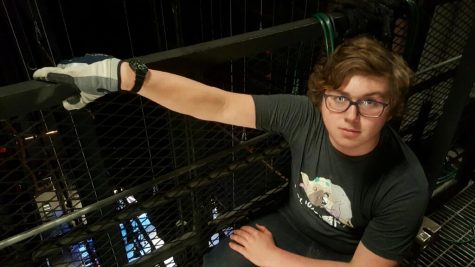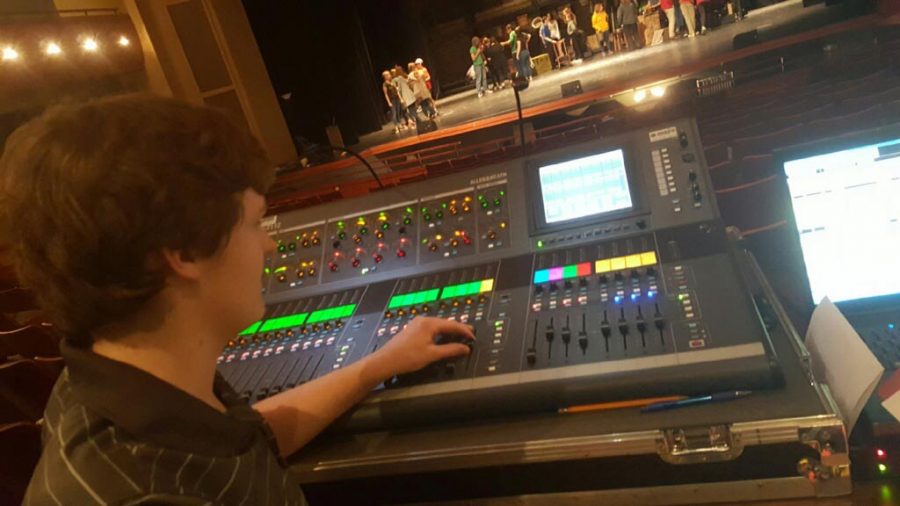Behind the Scenes with the Pit and Crew of Oliver!
Gage Gosset (’17), stage manager, manages the sound system during a dress rehearsal at the Wilson Center.
Audiences were enraptured as the actors and actresses of BC’s musical Oliver! whirled around onstage at the Sharon Lynne Wilson Center, Nov. 18-20. However, the magic of the stage would not have been possible without two important groups: the pit orchestra and the stage crew. For over two months, members of these lesser-known (but certainly not lesser) groups were hard at work alongside the cast. Some, like Henning Mahn (’18) and Abby Hill (’18), handled multiple duties at once; Mahn played as both Mr. Bumble and assistant stage manager, while Hill participated in both pit and crew. The week before the show, known as “tech week,” was a particularly hectic time for everyone involved.
November 12 – November 17. Tech Week.
On Day One, members of the stage crew break down the set into pieces, ready to send the whole thing to the Wilson Center in truckloads. The sun has long set before the crew is relieved for the day.
The next order of business is to unload and put it up again. On Day Two, another thirteen hours is devoted to this job, but by the end, the set is looking sharp. The rest of the week is similarly busy; cast, pit, and crew are called out of school for seemingly endless hours of practice and rehearsal, getting themselves accustomed to the stage where they will perform the upcoming weekend. Stage manager Gage Gosset (’17) conducts a series of rigorous check-ups with everything that needs to go right during the show – lights, scenery drops, cues, and rails. Regarding the whole endeavor, Gosset only has four words: “it is extremely hectic.”
Hectic isn’t necessarily a bad thing, however. “The crew is having just as much fun as everybody else is,” Mahn says. “The stress is a part of it. It’s something you look forward to, and at the time it’s very frustrating…but it’s all part of the process, and in the end it all makes for a good show.”

Henning Mahn (’18), right-wing stage manager, poses up on the weight loading catwalk behind the scenes of the stage.
A brief period of solace for pit comes after the umpteenth playthrough of “Consider Yourself,” a major “problem piece.” During this downtime, violist Ben Tan (’19) peers from the pit at the bustling cast – or tries to, anyway. The view isn’t all that great down there. Meanwhile, violinist Andrea Grimaldo (’18) chuckles as she watches a couple of other pit members put on their own production of the musical, imitating the cast members up above. “We all have a character we just really like to imitate, and it’s just really funny to see every pit member’s acting skills,” Grimaldo says.
Pianist Eric Chen (’18) sits near the rear, trying to forget the deluge of homework that awaits him once the night is over. (As he would later say, “if I hadn’t had a study hall this term, I probably would’ve drowned in my homework.”) He stares blankly at the plastic dinosaur sitting on the stand of Mr. Rothschadl, the pit conductor. Members of “Jurassic Pit” are still uncertain as to who is responsible for this inside joke, but they share a smile nonetheless.
November 18. Opening Night.
7:00 p.m., 30 minutes to curtain.
The pit and crew members begin filing in, ready for their first show of the weekend. Chen and Grimaldo chitchat with other pit members as they await the signal to tune. Gosset makes sure everything is set up properly, conducting his final checks. He makes his way to his booth in the rear.
7:20 p.m., 10 minutes to curtain.
Grimaldo softly twangs her A-string, partly to make sure it is still in tune and partly to calm her nerves. “It’s what we’ve been waiting for for the past two months,” she thinks to herself. “It’s finally here.” She feels for the energy of the crowd – something that, according to her, would subtly change between show to show.
Mahn, preparing his Mr. Bumble costume, shifts his mind into stage-acting mode. Angelina Gagliano (’18) will be covering for him on the right wing while he delivers his lines.
7:30 p.m.
Musical director Tommy Lueck, looking dapper in his tuxedo, takes the stage. After thanking supportive family members and various sponsors, he takes a bow. Down below, Mr. Rothschadl’s baton gives the first cue of the night, and the show begins.
“I really was just super excited,” Tan says. “We had all been working so hard to make the show as great as possible, and it was finally time to show off what we had.”
After finishing “That’s Your Funeral,” the last song in his opening scene, Mahn wastes no time in heading back to his position in the right wing. He removes his coat, tie and hat, recovering his headset from Gagliano and shifting back into crew mode. Just as he had practiced in rehearsal, he puts on his headset and prepares to lend a hand for the next operation of the fly rails – the system of ropes designed to pull things in and out of the stage. “This show was extremely drop-heavy,” Gosset says. “[The flys] were the most significant source of problems in the show.”
For the rest of the show, he keeps a sharp eye and keen ear to make sure everything goes right as he directs scene changes, helping out wherever the crew members were having trouble keeping up. “For certain scene changes, I’d be helping them move things; for certain scene changes, I’d be doing flys,” he says. “I was basically filling in for whoever needed support.” Mahn has another two scenes to play, but that doesn’t come until halfway into Act Two. His costume sits on a table nearby, awaiting those scenes.
During the periods of the show where the pit is not needed, Grimaldo silently follows along with the script of the cast. “By the time the show is over,” she says, “I basically know all of the dialogue, forwards and backwards.”
“I’m sure people think our job is really easy because we have the music right in front of us the whole time, but in reality, we have to watch and listen really carefully,” Tan says. Careful attention and adaptation is often required to match what the singers onstage are doing – speeding up, slowing down, becoming more expressive, growing quieter, or any number of other minute adjustments that may need to be matched. There is only so much preparation they can do beforehand.
11:00 p.m. The conclusion of the show.
The final note of the final song hangs in the air and reverberates around the space. After a moment, the audience applauds, and the bows begin. Though the unsung pit orchestra below is not visibly recognized, they still take in the applause with pride.
The audience finally gains a glimpse of the diligent stage crew that had made just about everything possible. Mahn in particular draws attention, as he first bows with the cast and then steps forward to bow again – in full costume – with the significantly less conspicuously dressed crew members. “I definitely wanted to identify with both groups,” he says.
Thus, the cast, pit and crew conclude a truly magical performance.
Now to do it three more times…





Paul M • Jan 25, 2017 at 5:31 pm
Fun tribute to the unsung heroes of Oliver! Fun to read about Henning’s role(s).